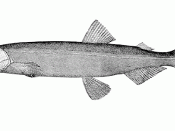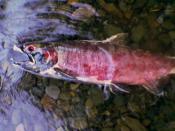There is a huge sound, as the perfect large mouth bass jumps after a low flying bug. With one gulp the fly is gone and so is the bass. The large mouth bass is one of the best predators of the water. With no warning of attack it jumps out and kills its prey. The large mouth bass uses many of the fourteen behaviors. The one used most often however is ingestive. The bass uses all of its behaviors to go after its food. The fourteen behaviors are investigative, ingestive, shelter-seeking, agonistic, care giving, care soliciting, eliminative, allelomimetic, sexual, play, sleep, use of tools, thermoregulation and social. While the bass not use all of these it uses most of them.
The large mouth bass is very unique from the other members of the bass family. The large mouth bass is the most adaptable member of the bass family. It is found in every aquatic habitat from small streams the the largest resevoir, and almost everything in between.
Up north the large mouth bass has a longer lifespan than in the south, at sixteen years old. While it may get older up north the size of the bass is larger in the south. This is so because there is more to eat.
The sexual characteristics of the bass remain the same nort and south. The large mouth bass spawn in the spring, when water temperatures begin to move past sixty degrees fahrenheit. The spring spawning urge in a bass is set off by both water temperature and photoperiod. Photoperiod is the proportion of the day in which the bass are exposed to sunlight. As the day light hours grow longer through the spring and early summer, so does the photoperiod. This process affects the temperature of different bodies of water in...


